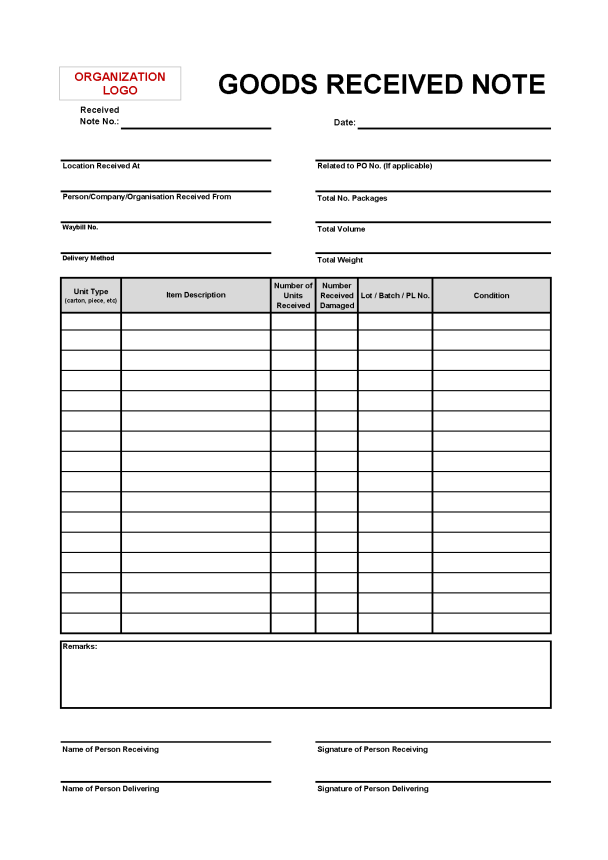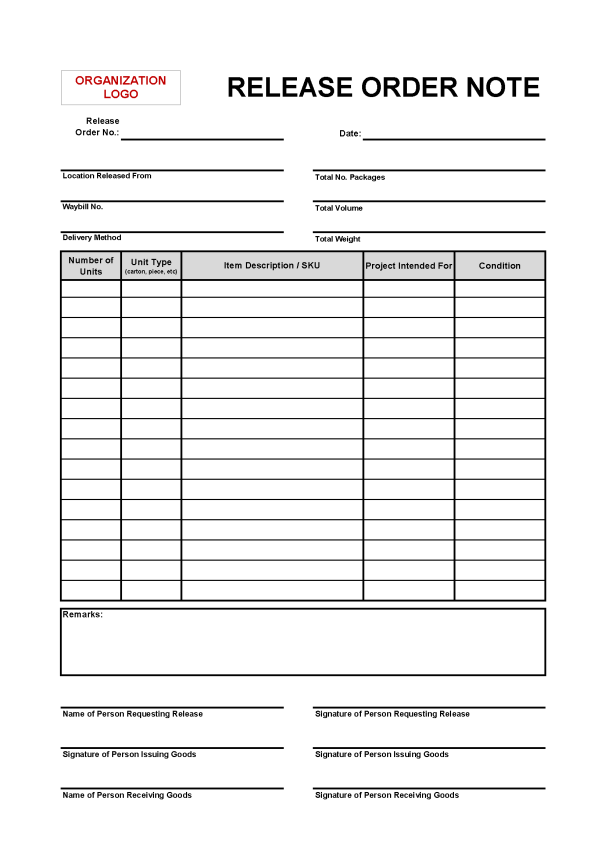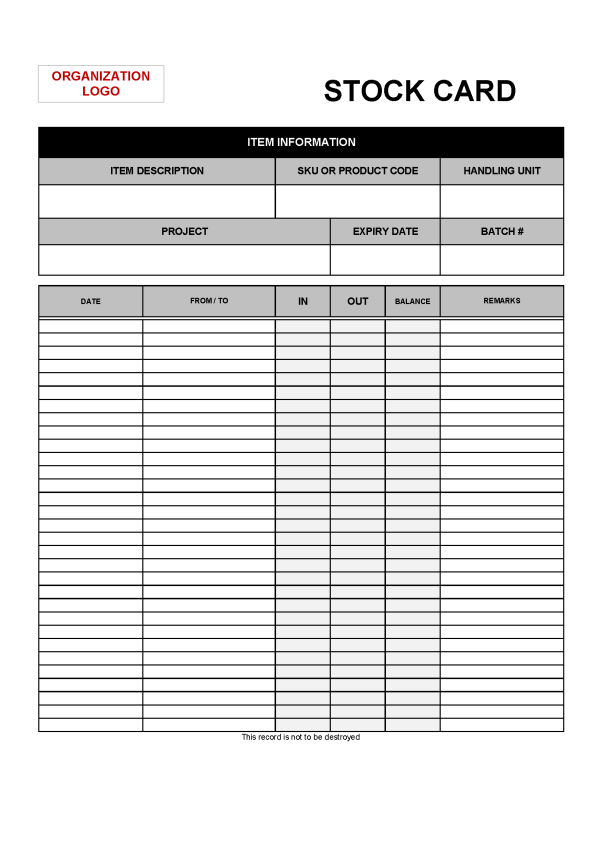The documentation requirements for warehousing can be vast, depending on the type of warehouse, regulatory controls over the stock or the facility, the types of commodities stored, or the specific activities of the agency running the facility. Documentation might include inspection reports, fumigation schedules, repairs, import/export documents related to bonded storage and more.
As an overview, most humanitarian agencies will use at least several standard documents across all of their storage operations, including large professional facilities all the way down to field level storage. These documents are essential for the proper audit and tracing of cargo as it flows in and out of agency managed facilities. It is important that this standard document be accurate, and that copies are properly kept – both at the site of operation, and eventually scanned/backed up in another location for wider historical record keeping.
Waybill/Delivery Note – Warehouses will often use common waybills as part of the overall documentation process. Waybills – also sometimes called “delivery notes” - come in many formats, and can represent either domestic or international deliveries. Waybills also tend to be generated by external third-parties, and are used for their own third-party tracking needs. If properly handled, at least one copy of the incoming waybill should stay with the receiving party (warehouse). If a copy cannot be left with the warehouse, the receiving warehouse should attempt to electronically scan a copy of the waybill, including all signatures and notes on it as evidence of delivery.
As cargo leaves the warehouse, waybills will also be generated. Agencies may wish to generate their own agency specific waybills to accompany cargo they pack and load. In other situations, third-party vehicles may generate their own waybills on the spot. In either case, warehouse workers loading cargo onto vehicles must ensure that the information contained on the waybill is accurate. Situations in which organisations may choose to use self-generated waybills may include:
- The vehicle is managed/owned by the agency.
- The destination of the vehicle is a facility or distribution site managed by the agency.
- The contract with the third-party trucking company stipulates that they must use agency specific waybills.
Goods Received Note (GRN) – Some form of GRN is typically generated at the point of reception into a warehouse facility. A GRN will theoretically contain the same information on incoming shipments as a waybill, but a GRN serves a few key functions:
- A GRN may capture information on multiple consignments arriving at once.
- GRNs may take the place of waybills, which may show up with incomplete or incorrect information, or may not come at all.
- GRNs are a form of standardising incoming information in the format most useful to the organisation.
- With proper planning, a GRN can be generated prior to a shipment arrival so warehouse crews know what to expect at the point of offloading.
GRNs should capture dates, locations, persons involved in the transaction and the contents of the cargo entering the warehouse. The exact structure, contents and sequence of a GRN vary depending on needs – as an example, an organisation focused on medical interventions may need to track batch and lot numbers, while an organisation focused on food may choose to track items by the kilogram. Organisations should consider their own internal requirements when drafting a GRN.
Example GRN:
Goods Release Note/Stock Release Order – A goods release note serves a similar function as a GRN, however a release note’s goal is to capture the information on items as they leave the warehouse. Many organisations choose to use the release note the same as an official pick-order; the requesting party initiates the release note indicating which items are required, and obtains counter signature from the appropriate entity within the organisation. A completed release note will capture the final dates, quantities and persons involved with the loading all the way to the truck. A proper release note will tell a story of what was removed, why and by whom. Many agencies don’t actively use release notes, opting to only use waybills at the time of release or communicating pick-orders via email.
Example Release Order:
Stock / Stack / Bin Card – A stock card is a physical, hand written record that stays alongside the corresponding physical cargo inside a warehouse or storage facility. Stock cards are sometimes referred to as “stack cards". The nature of the tracking stock card does not change, however – its purpose is to trace the history of the physical consignment in a quick and easy to reference manner.
Example Stock Card:
A stock card should at the bare minimum include:
- The item description.
- Any consignment or procurement relevant information.
- Dates and quantities of cargo items received.
- Dates and quantities of cargo items released.
- Running total balance.
Certain types of goods requiring more meticulous control and analysis, may and need to be tracked using stock cards with specific information, including but not limited to:
- Project or donor earmarks.
- The SKU code (if available).
- Relevant product info - Expiration dates, batch numbers, lot numbers, date of manufacture.
- Reorder threshold.
- Manufacturer references.
- Temperature control requirements.
The stock card has inventory control purposes and is normally managed by the store keeper and updated immediately with each stock movement, including losses. The use of stock cards is imperative in all warehouses, even if the number of articles is short or there is limited rotation. In an ideal context, any warehouse worker on the floor should be able to quickly reference a stock card for the most up to date information on the status and flow that specific good in a warehouse. Quantities and dates on stock card should also match the quantities and dates on a inventory ledger, GRNs and waybills.
For some items, bin cards can be introduced. These may have a similar format as the stock card but are fixed to the bins or shelves where the items are kept. Bin cards track movements of an item stored in a particular bin, shelf or stack. Bin cards are used when big quantities of the same item are stored, requiring some kind of grouping, easing handling, picking and counting processes.
Inventory Ledger – A inventory ledger is defined as any system that keeps a running history and current total of all cargo items in a storage facility, as well as all relevant information (expiration dates, donor information, etc). The inventory ledger also tracks inventory transactions (receptions and dispatches) in terms of quantity and value based on the information from the corresponding transaction document. This tool has accounting purposes and is normally managed by an tally clerk or other specialised person focused on accounting for stock, and updated in a regular basis (weekly, monthly).
There is no one standard for a inventory ledger system. Historically, running inventory ledgers were recorded by hand in a book, but modern systems may use computer-based spreadsheets, specially designed software, web-based tracking, and more. The important part is that a warehouse manager can quickly and on-demand find relevant information for any stock item contained in the warehouse through a single centralised system.
Templates of warehouse goods flow documentation can be found in the reference section of this guide.





